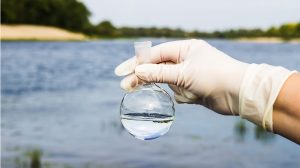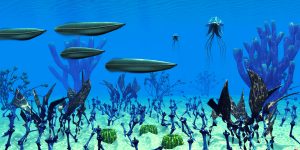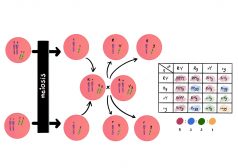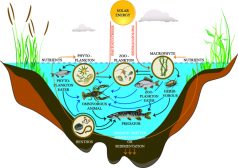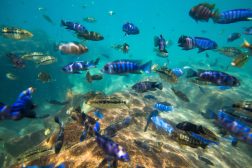Table of Contents
Definition
noun
plural: abiogeneses
a·bi·o·gen·e·sis, eɪbaɪəʊˈdʒɛnəsɪs
(1) The idea that primitive life originated from nonliving matter (e.g. simple organic compounds) over a span of millions of years; autogenesis
(2) Spontaneous generation, i.e. the previously popular notion that living organisms could spontaneously arise or develop from nonliving matter
Details
Overview
Abiogenesis is the idea that attempts to relate as to how life originated. It used to refer to the now-discredited hypothesis of spontaneous generation. It was once believed that complex living organisms such as mice, maggots, etc. could arise spontaneously from nonliving matter. This notion used to be popular that it was long held by early thinkers for many years until experiments by Louis Pasteur and others proved it to be false. Now, the idea is superseded by biogenesis, which asserts that living things can only be produced by another living thing, and not by a non-living thing. The modern hypothesis of abiogenesis is now restricted to the presumption that the relatively simpler, earliest forms of life arose from nonliving matter, such as organic compounds, and the process that eventually led to this transition was gradual, not a single event, and estimated to have taken place for over millions of years.
Obsolete abiogenesis
Spontaneous generation refers to the previously popular thought that the apparently complex living things (such as maggots) could form from inanimate objects in a matter of minutes, hours, days, or years. It could also pertain to the process that supposedly led to the formation or development of a living thing from a nonliving thing.
One of the most influential proponents of the idea of spontaneous generation is Aristotle. He believed that plants and animals reproduce by spontaneous generation apart from sexual and parthenogenetic means. According to his book, History of Animals, while some animals could grow from their parent, others could grow spontaneously.‘1 Jean Baptiste van Helmont 1580–1644, a Flemish chemist, physiologist, and physician, came up with a recipe to create mice. According to him, the wheat would transform into mice in after about 21 days by allowing the leaven to react in the shirt with fumes from wheat. As for his recipe for scorpions, the ingredients were a carved brick filled with basil. These were just one of the prevailing thoughts on how life could emerge from inanimate objects.2
In a spontaneous generation, people thought that a living organism could appear from non-living materials, without the need of a biological precursor, such as a parent. This has become an obsolete thought when it was demonstrated to be a fallacy by verifiable experiments, especially those of Francesco Redi 1626–1697, the Italian physician and naturalist who was the first to refute spontaneous generation, and Louis Pasteur 1822–1895, a French biologist, microbiologist and chemist that irrefutably disproved it. With the advent of laboratory tools and microbial techniques, empirical evidence demonstrated that living things could not be generated spontaneously from inanimate objects. Only living things are capable of reproducing another life. Thus, the theory of spontaneous generation became obsolete and supplanted by the theory of biogenesis. The basic tenet of biogenesis lies in the thought that life arises from similar life forms. The terms abiogenesis and biogenesis were coined by Thomas Henry Huxley 1825–1895. He proposed that the term abiogenesis be used to refer to the process of spontaneous generation whereas the term biogenesis, to the process where life arises from similar life.
The modern context of abiogenesis
The modern idea of abiogenesis holds that the primitive life on Earth originated from lifeless matter and it took millions of years to transpire. It is different from the obsolete idea of abiogenesis. In the modern context, it speaks of living things that were not yet as complex or elaborate as the life forms of today. How abiogenesis occurred is still a mystery. It probably incorporated various processes such as self-replication, self-assembly, autocatalysis, and cell membrane formation.
Life is built upon the four major biomolecules: carbohydrates, lipids, amino acids, and nucleic acids. Of these biomolecules, the nucleic acid, RNA, can function as both genetic material and a catalyst. Thus, it is hypothesized that the primitive life was likely RNA-based and that life emerging from the non-living came about as a gradual process that took millions of years. And, this transformation of non-living matter into a living entity has not been repeated since then.
From the initially simpler forms, living things became more and more complex and they diversified. They have become more adapted and sophisticated as manifested by the evolution of their elaborate physical and genetic attributes.
Earth is said to be about 4.54 billion years old and life likely started around 3.5 billion years ago or earlier. According to the hypothesis of primordial soup, the primitive Earth is hypothesized to resemble a soup where organic compounds were synthesized in a large body of water.
In the Miller-Urey experiment, the simulated-primitive Earth favored the chemical syntheses of the fundamental structures of the cell membrane. One of them was phospholipids, which by nature are capable of forming lipid bilayers.
One of the well-known hypotheses is the RNA world hypothesis. It holds that primordial life was based on RNA, being a genetic material, and at the same time, a catalyst. The RNA-based life might have dominated the primitive Earth and served as the descendants of the current life on Earth.
RNA, as well as DNA, components might have come from and synthesized in the asteroids from outer space. They probably reached the Earth through meteorites. NASA reported that they found RNA and DNA nucleobases (e.g. adenine, guanine) in meteorites.3 They could have led to the spontaneous creation of RNA and DNA on Earth.
Research
Research on abiogenesis encompasses molecular biology, biochemistry, biophysics, astrobiology, paleontology, and oceanography. Scientists explore to find fossil evidence that will shed light on the origin of life, particularly the origin of the major biomolecules. As of 2017, the 3.77 to 4.28 billion-year-old fossil found in Quebec, Canada, is regarded as the oldest proof of life on Earth. It suggests that life began after the ocean formation, which occurred 4.4 billion years ago.4
Supplementary
Etymology
- origin: word (translation, “meaning”)
- Ancient Greek ἀ- (a-, meaning “not”)
- Ancient Greek βῐ́ος (bíos, meaning “life”)
- Ancient Greek γένεσις (génesis, “origin”)
Synonyms
- autogenesis
- biopoiesis
- abiogeny
Derived term
- abiogenetic (adjective, of, or pertaining to, abiogenesis)
Further reading
Compare
See also
Reference
- Aristotle. (1910) c. 343 BCE. “Book V”. History of Animals. Translated by D’Arcy Wentworth Thompson. Oxford: Clarendon Press. ISBN 90-6186-973-0. Retrieved from Link
- Simon, S. (2014, June 4). Fantastically Wrong: Why People Once Thought Mice Grew Out of Wheat and Sweaty Shirts. Retrieved from Link
- NASA – NASA Researchers: DNA Building Blocks Can Be Made in Space. (2011, January 1). Retrieved from Link
- Dodd, M., Papineau, D., Grenne, T., Slack, J., Rittner, M., Pirajno, F., … Little, C. (2017). Evidence for early life in Earth’s oldest hydrothermal vent precipitates – White Rose Research Online. Whiterose.Ac.Uk. PDF
© Biology Online. Content provided and moderated by Biology Online Editors


